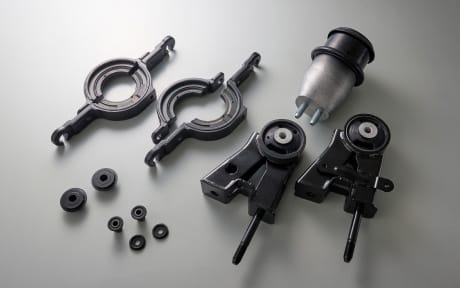In the same way electric vehicles (BEVs) send electricity from the battery to the motor, fuel cell vehicles (FCEVs) convey hydrogen to the FC stack, and hybrid vehicles (HEVs/PHEVs) send electricity and fuel to the motor and engine, respectively. At such time, sealing technology that ensures that electricity and hydrogen does not leak is essential for safety. FCEVs that use hydrogen as fuel particularly require a higher level of technology. Sealing technology is the technology that creates this kind of insulation and dust-tight sealing environment. This technology can also be used for the development of commercial vehicles such as trucks and buses, and train carriages. The application of this technology into fields outside of the motor vehicle framework will also contribute to the creation of a decarbonized society.
Needs
In addition to BEVs, FCEVs are expected to become next generation of eco-friendly cars by not emitting any carbon dioxide and only emitting water while running. FCEVs are required to convey hydrogen (the fuel) from a tank to an electric power device called a FC stack. As hydrogen is a substance that can very easily cause a chemical reaction, it must not leak externally. Consequently, hoses that convey hydrogen and parts that connect hoses to other hoses require extremely precise technology. It is therefore said that the establishment of a structure where hydrogen does not leak is essential for FCEVs to enter the mainstream.

Value
Sumitomo Riko has developed hoses that convey high pressure hydrogen that cannot be leaked using its own material compounding technology. We also developed a barrier design where hydrogen does not leak for sealing the problematic joint section which contributes to the manufacture of highly reliable and durable parts for FCEVs. In addition, we develop and supply rubber sealing material in the shape of a hydrogen flow channel for the electric power device, FC stack. As with hoses, hydrogen must never leak from this component. The birth of these advanced and accurate materials provide the impetus for the wide adoption of the next generation eco-friendly cars.

Hydrogen Hoses
These hoses supply hydrogen stored in the hydrogen tank to the FC stack. They correspond to the extremely advanced sealing requirements needed to seal small particle hydrogen and do not leak any hydrogen externally under any circumstances.

Fuel Cell Gaskets
The FC stack contains hydrogen, oxygen and rubber sealing material to prevent water from leaking. The material is capable of sealing in temperatures ranging from sub-zero to 100℃ or higher and it contributes to the long-term stability and highly efficient power generation of FCEVs.

Anti-vibration Rubber for FCEVs
FC stack frame mount / Regulator mount / Hydrogen tank mount / Air compressor mount

Hoses for FCEVs
Hydrogen hose / Air hose / FC cooling hose